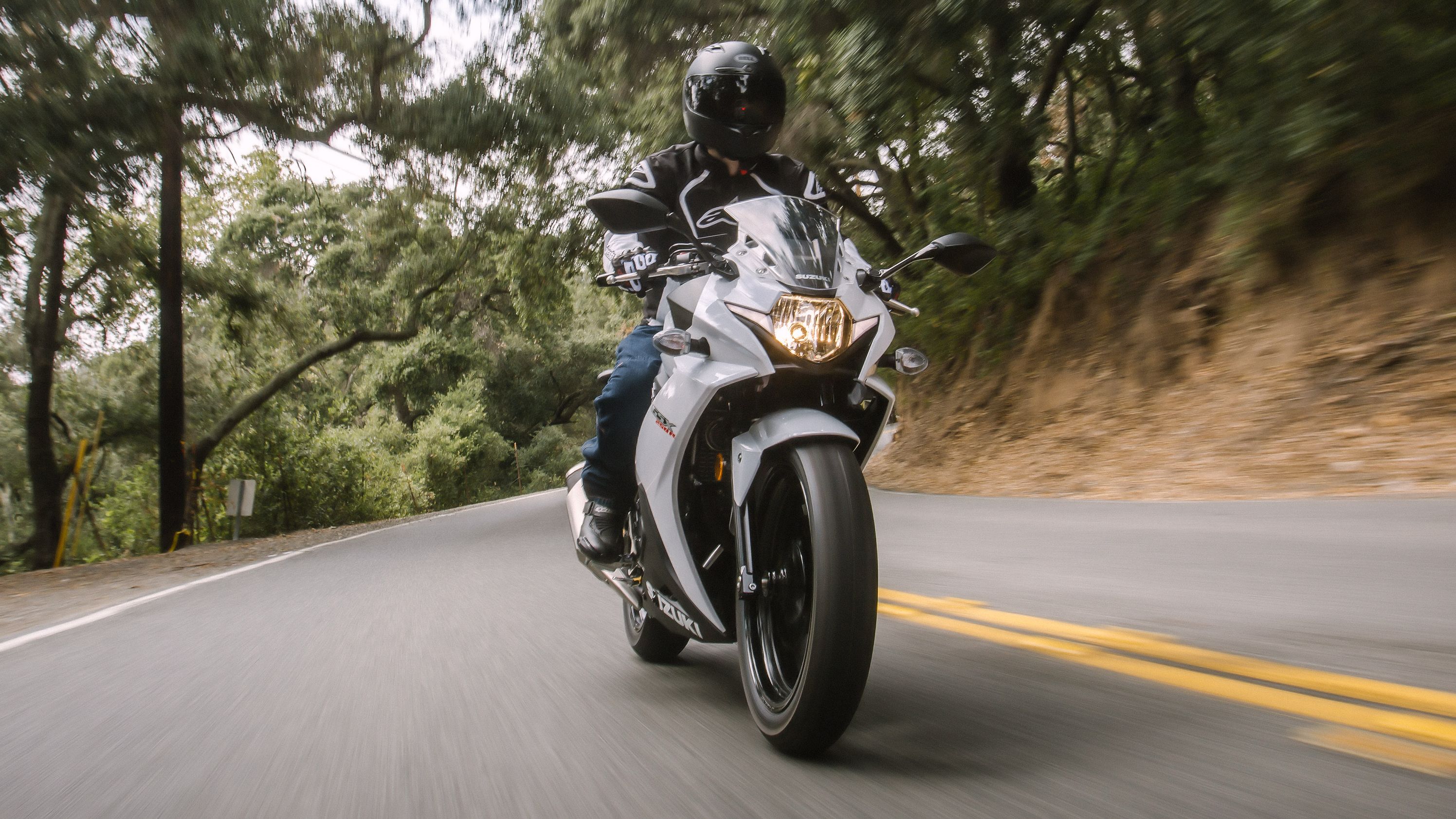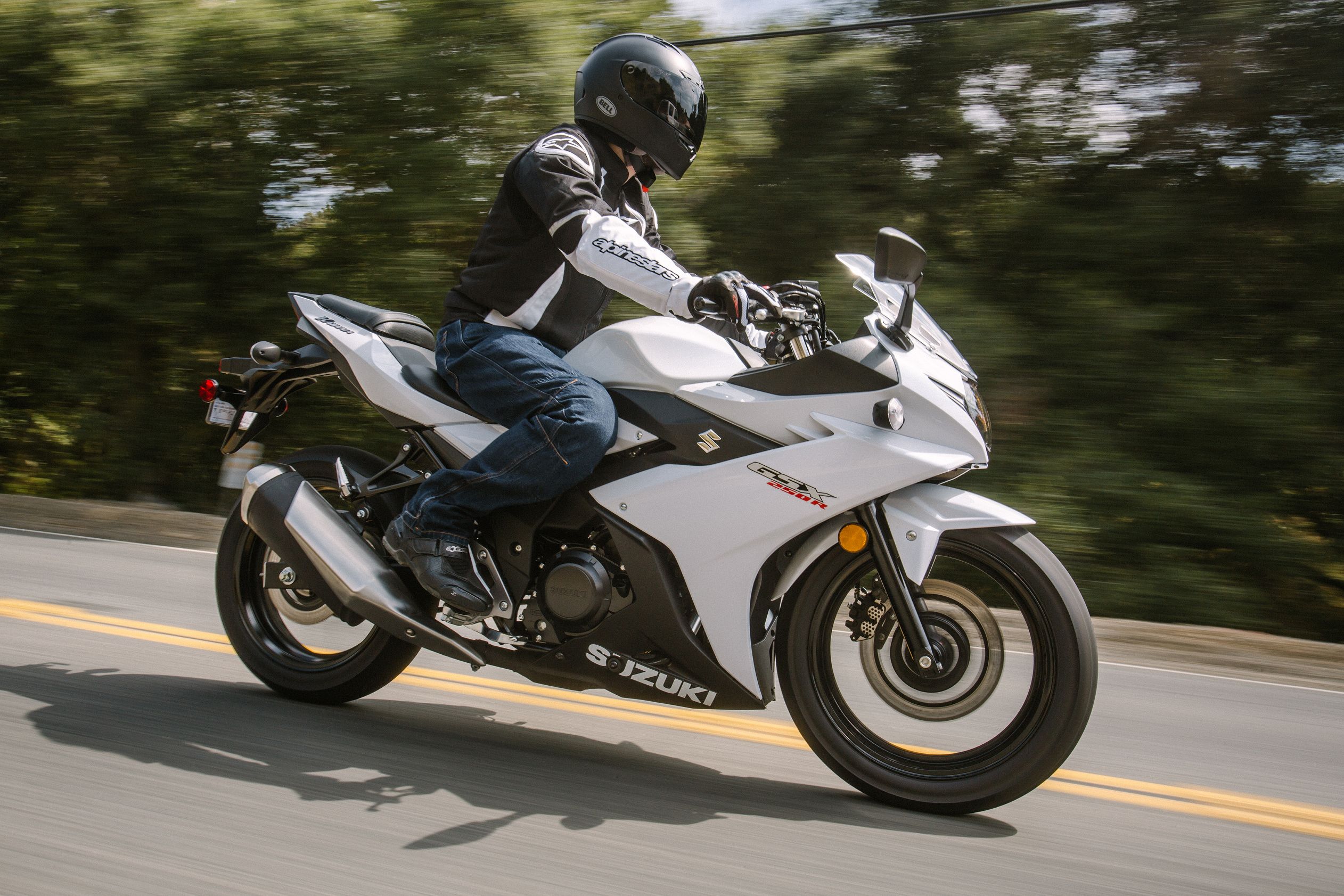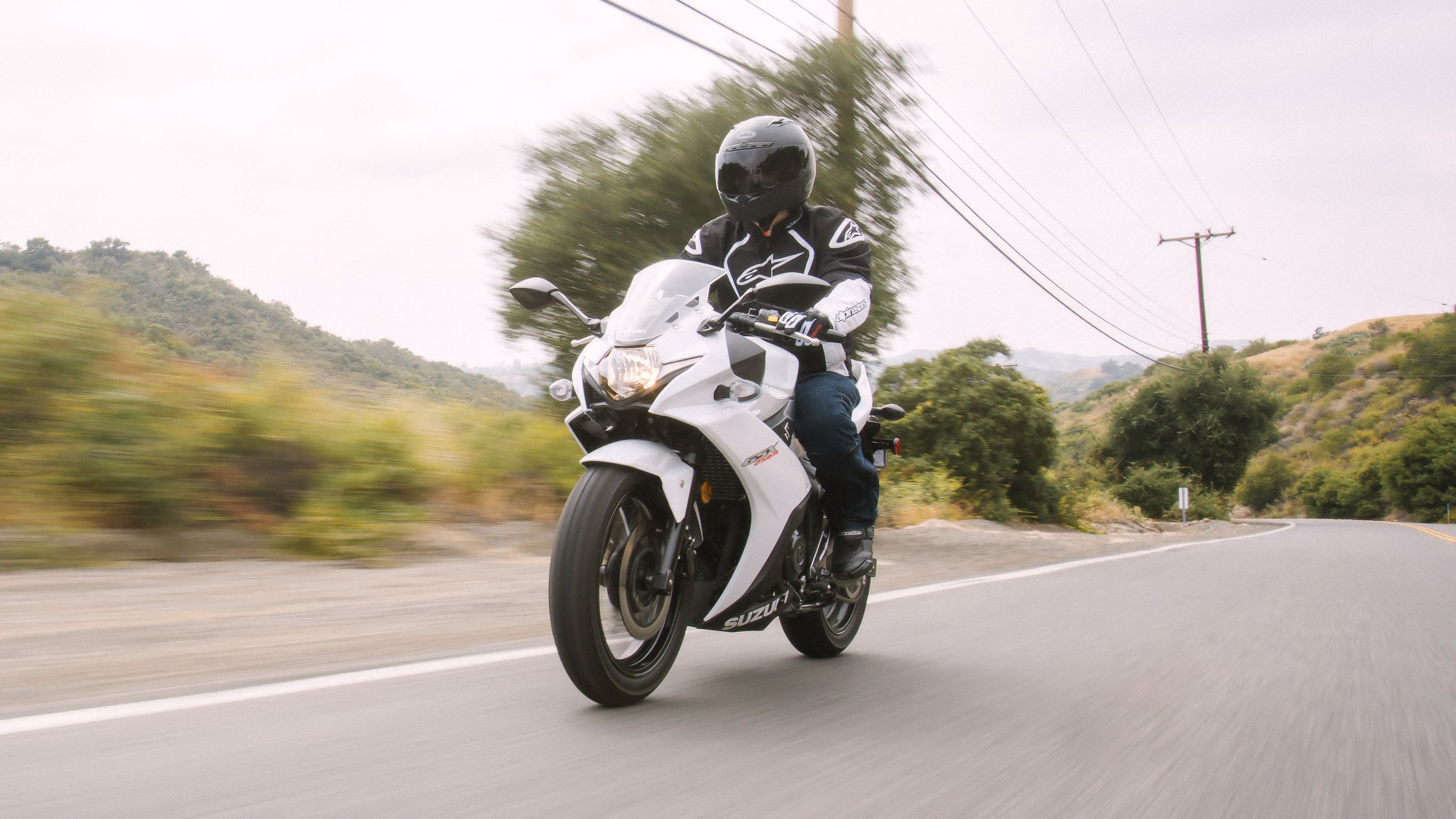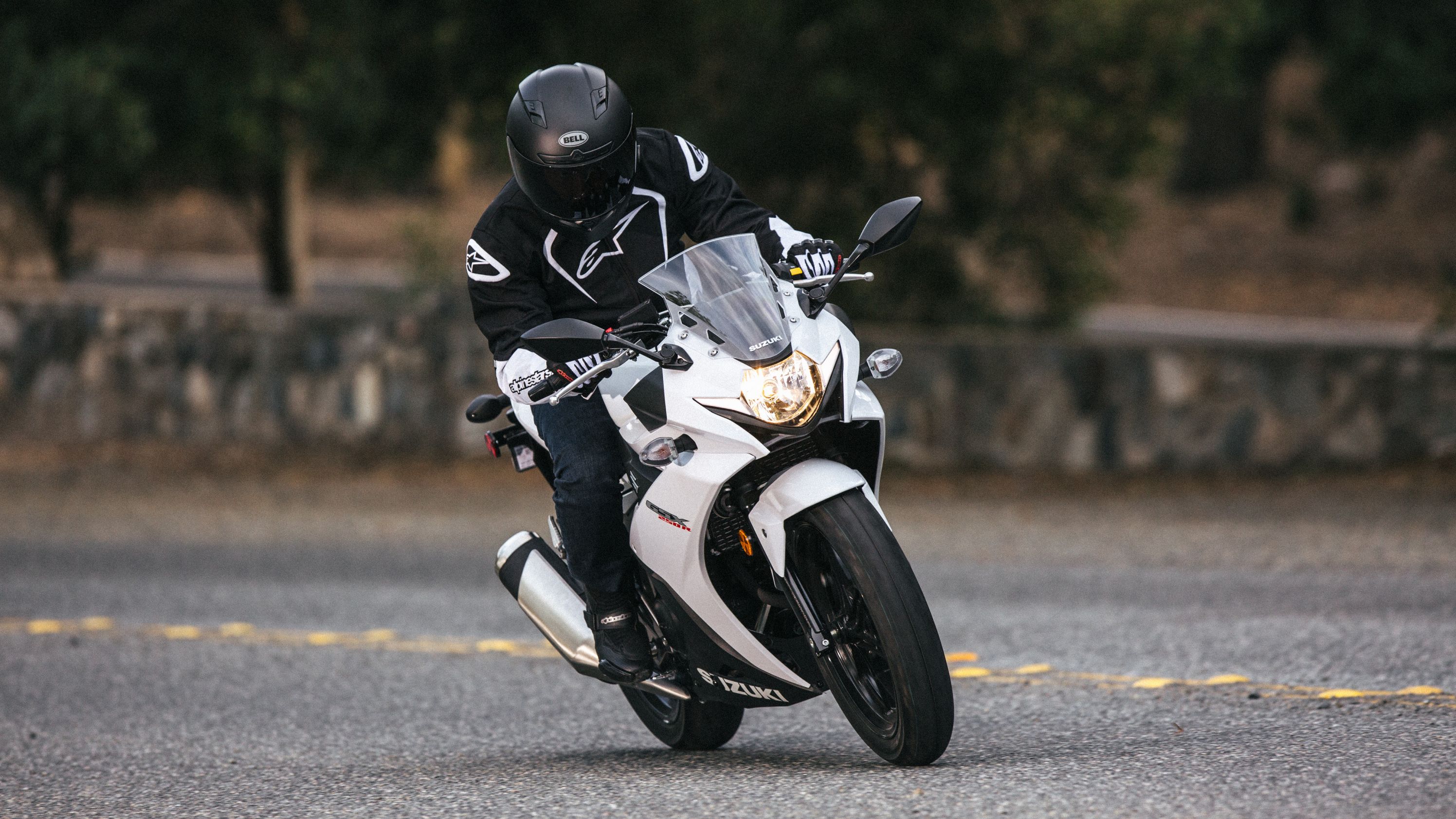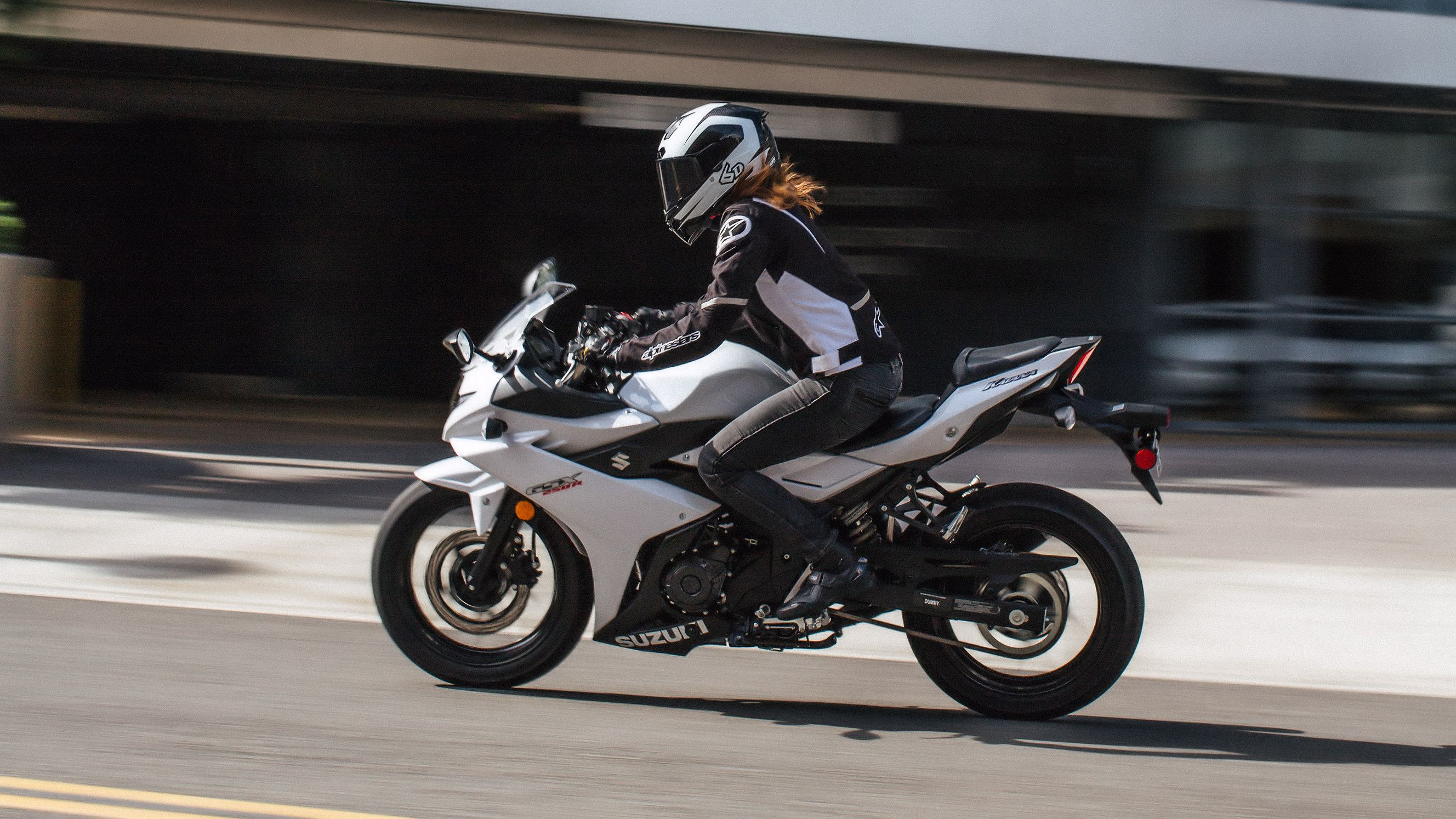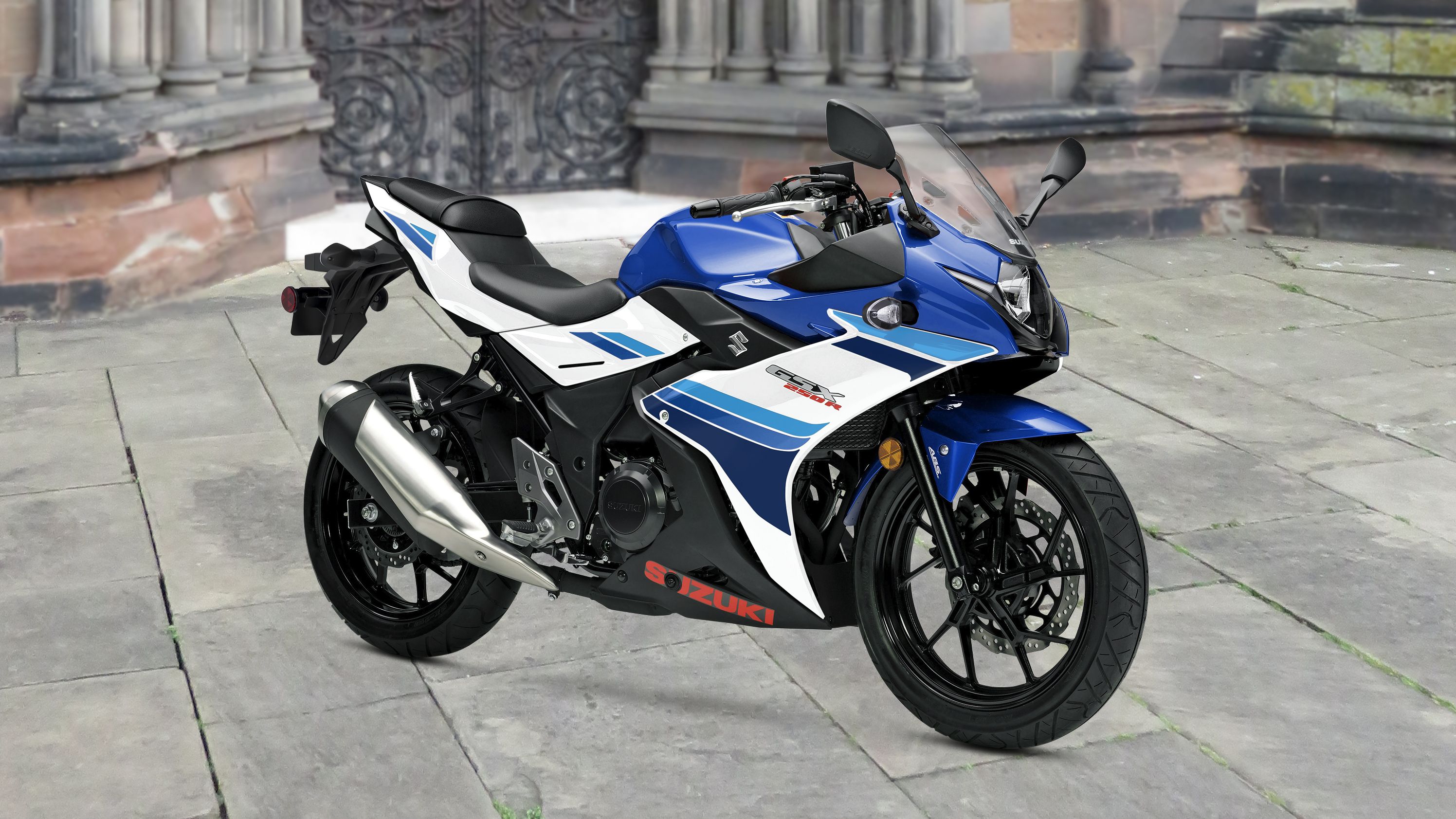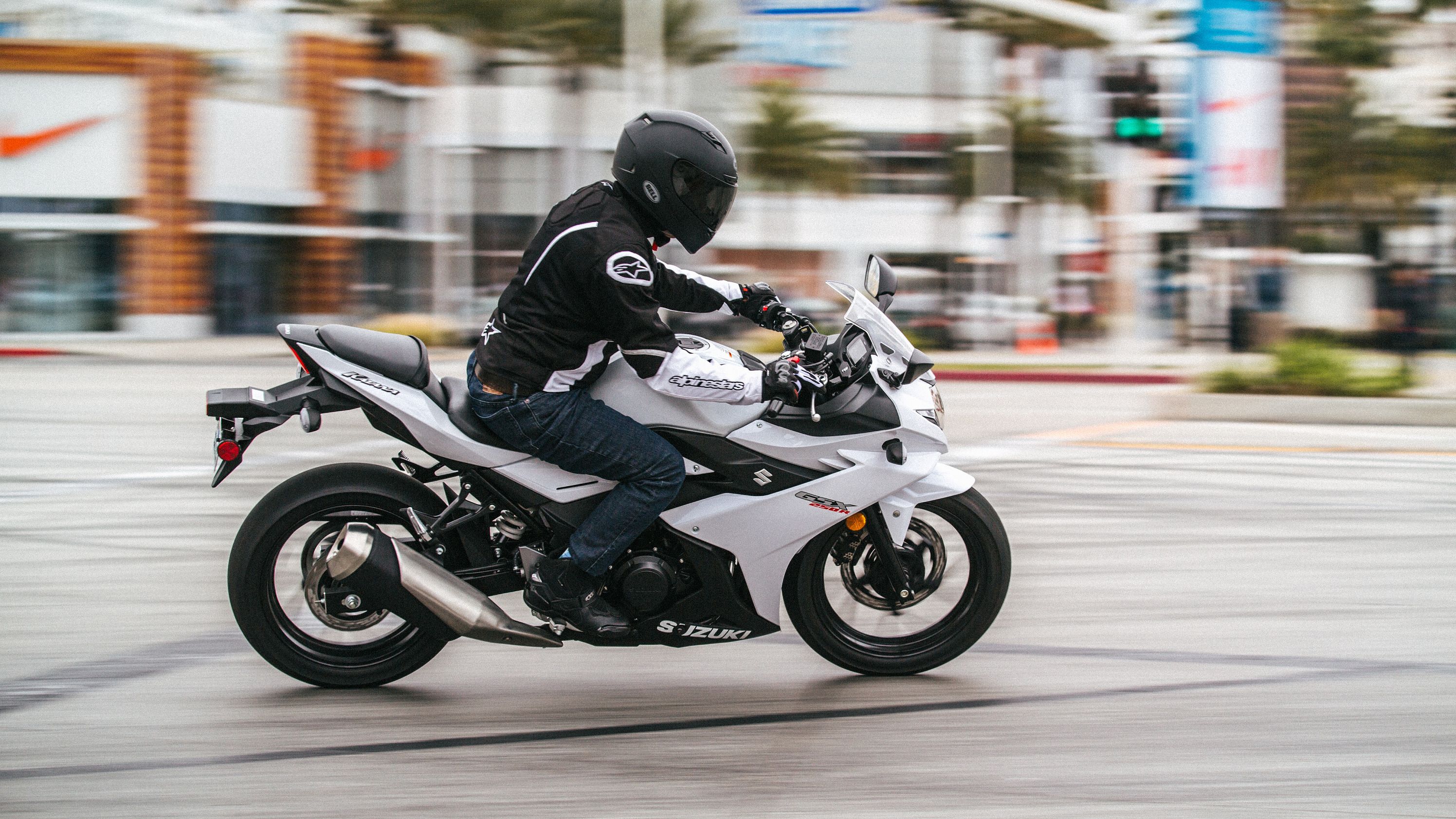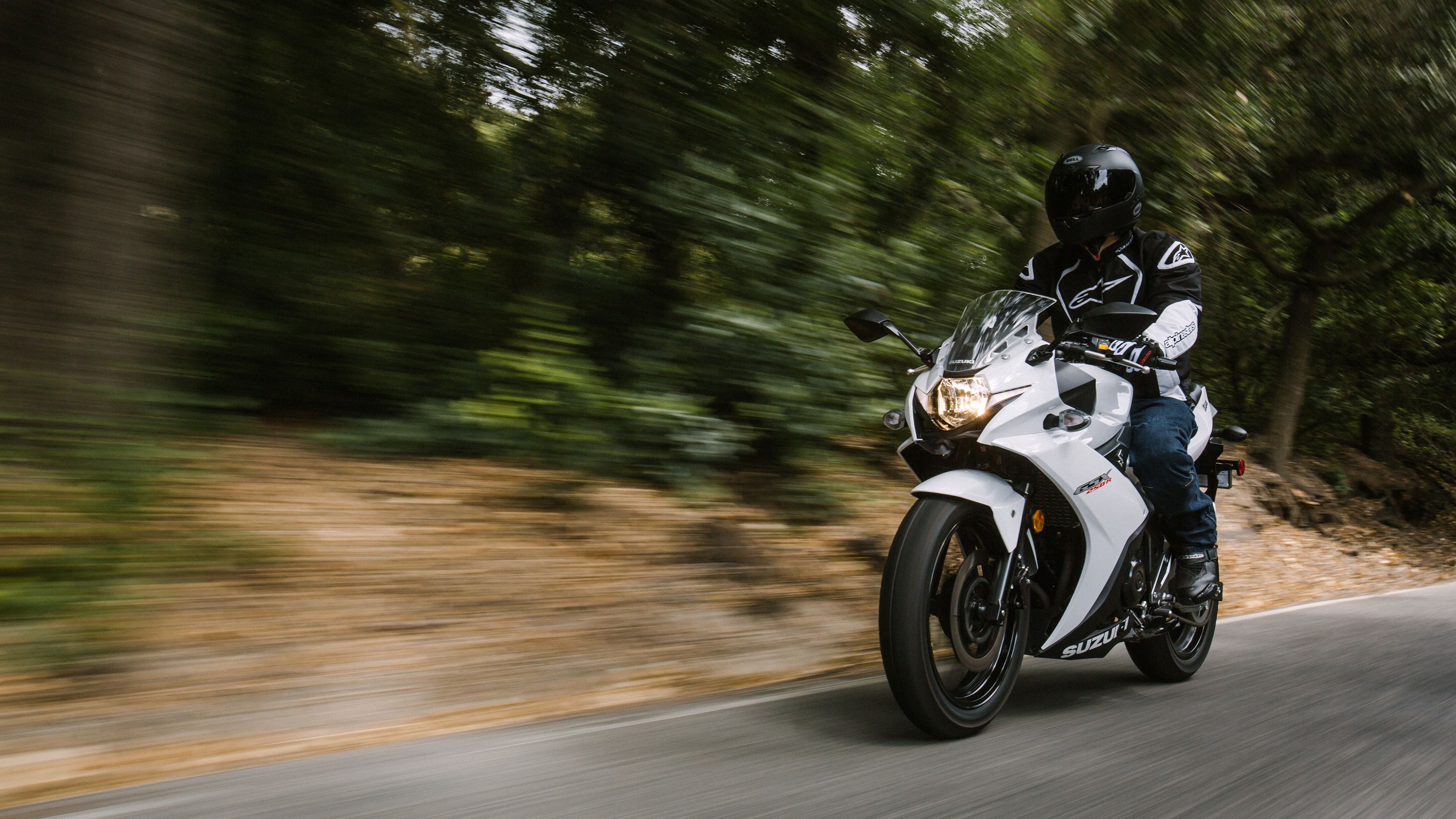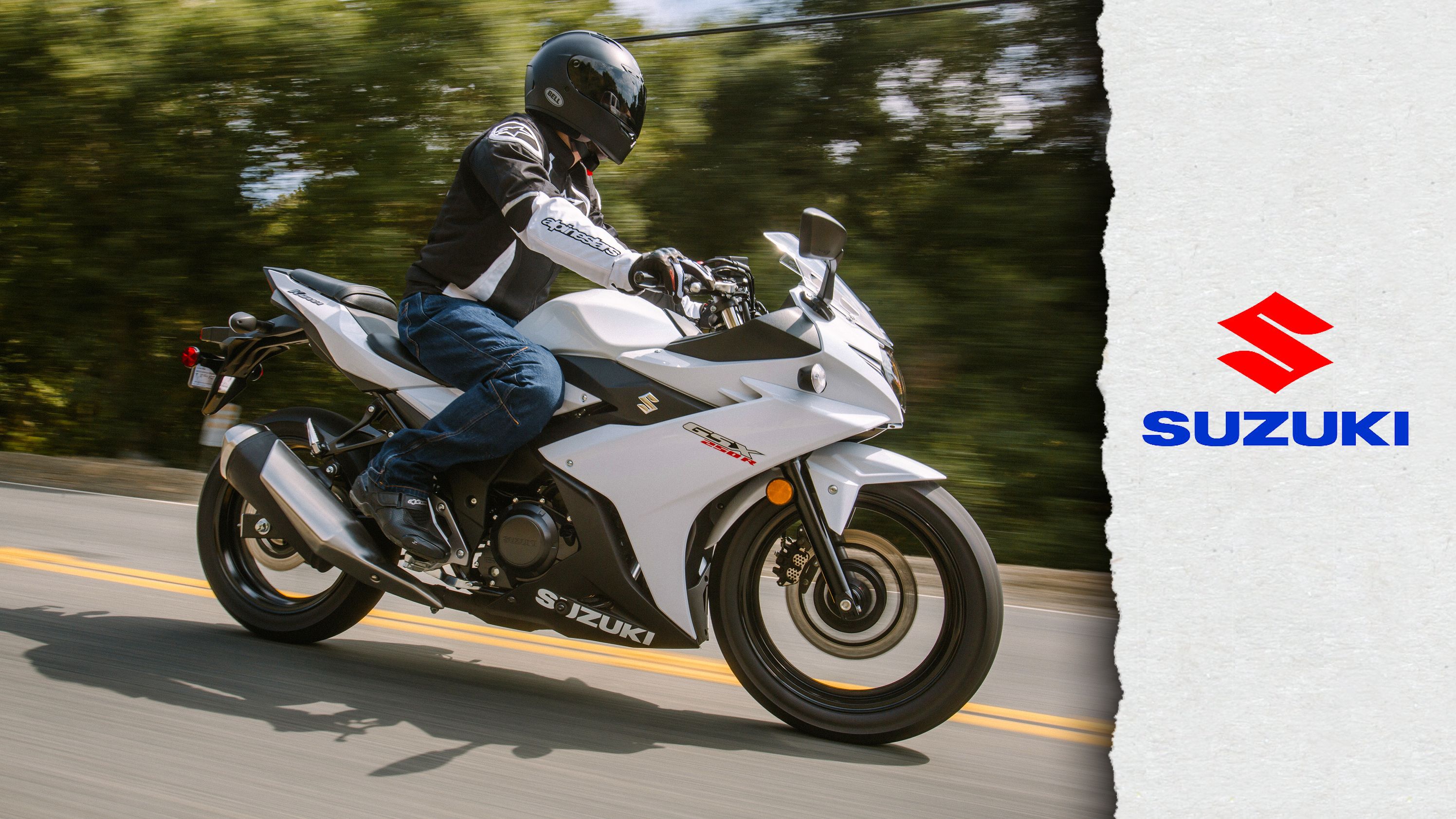All-new in 2018, the GSX250R from Suzuki is set to enter the race to the bottom. Not the bottom of the stack, but the bottom of the displacement range with its 248 cc fuel-injected, liquid-cooled, parallel-twin engine. Suzuki jumps on the go-small-or-go-home bandwagon with a sportbike carrying all the genetic markers of the Katana family, and exactly what you would expect from one of the Big Four.
Suzuki GSX250R Design
All the big names are out with 250-300 cc versions of their proven, big-bore bikes and here Suzuki has the GSX250R. After years of bigger/better/faster, many of the world's top sportbike manufacturers took a step back and expanded downward into the pocket-rocket displacements. Whether this was a response to a growing demand for small-engine sportbikes, or if the Powers-That-Be decided that manageable, entry-level trainers were needed to keep new riders from getting in over their heads right out of the gate.
This may be a small-displacement bike at only a quarter-liter, but the overall design and bodywork is very much based on established performance principles. A full fairin encloses and protects the innards while vents in the engine cowl prevent power-robbing turbulence and buffeting in addition to directing hot air away from the rider.
A cyclops headlight leads the way at the peak of the beak below the cut-down flyscreen, though the factory missed an opportunity to clean up the front end with recessed or mirror-mount turn signals, instead opting for winkers with short standoffs.
Below the headlight, the cowl opens up to scoop and funnels air over the radiator before it tapers back down to a natural chin spoiler. Only the merest glimpse of the engine is possible through the cutaway at the back of the cowl, so if you're into being able to see the mill, I suggest you shift your focus to the naked-bike category 'cause this ain't your kind of bike.
Short, clip-on bars and jockey-mount footpegs force the rider into an aggressive riding position, and even with arms straight most riders won't be able to sit completely upright. There is quite a bit of rise to the pillion pad, a detail that not only acts as a butt-stop for the pilot, but also provides the passenger with plenty of clean air and an unimpeded view forward.
A kicked-up subframe gives it the nose-down/tail-up pose that makes it look rather like a sprinter crouched at the blocks, which is perfect if you do indeed intend to use this ride as a trainer before moving into the bigger supersports, 'cause that's the same attitude the big-boy bikes display. Seat height is relatively low for a sportbike at 31.1-inches high, but folks with short inseams will be tippy-toeing this at the redlights.
Tubular steel members on the GSX250R make up the semi double-cradle frame that comes set up to resist the forces involved in carving the corners, and a yoke-style, two-side swingarm completes the standing gear. Suzuki tucked the rear shock away out of sight so it doesn't wreck the look of the ass end, but unfortunately, it also limited the adjustments to spring preload and nothing else. Granted, I know it's an entry-level bike and cost is a factor, but I am a firm believer that trainer machines should bear at least some of the cream you can expect in the higher-tier bikes. Just sayin'.
RWU KYB front forks likewise do the job, but offer none of the tweaks you can expect in the higher brackets. Petal-cut discs work with the calipers to slow the wheels, but are likewise simple with no combined brakes or any other fandanglery to complicate the works, though ABS was added in 2019 and the hand lever is adjustable to accommodate a range of hand sizes.
Cast, 17-inch wheels mount the 110/80 front hoop and 140/55 rear. They sport a Y-spoke pattern meant to be strong while keeping unsprung weight and windage to a minimum.
Suspension, Front:
Telescopic, coil spring, oil damped
Suspension, Rear:
Single shock, coil spring, oil damped
Brakes, Front:
Single disc, Nissin 2-piston caliper
Brakes, Rear:
Single-disc, Nissin 1-piston caliper
Tire, Front:
110/80-17M/C 57H tubeless
Tire, Rear:
140/55-17M/C 66H tubeless
Suzuki GSX250R Chassis
Suzuki GSX250R Drivetrain
Suzuki powers the GSX250R with a fuel-injected, liquid-cooled, parallel-twin engine. The factory built in details such as a street-grind cam for friendly and predictable power delivery with a revised valvetrain that sports roller-bearing rocker arms and tapered stems to reduce mechanical losses and increase volumetric efficiency.
If you're looking for traction control, power-delivery modes or any of the other rider crutches here, you're going to be sorely disappointed. There's nothing to see here but raw, honest control and feedback without all the extra complication and expense of the fancy stuff.
Slightly undersquare, the mill runs a 53.5 mm bore and 55.2 mm stroke for a total displacement of 248 cc. Electronic fuel injection manages the induction, but that's to be expected, and is the limit of the gadgetry. At 11.5-to-1 the compression ratio is a bit warm, so you can go ahead and get used to the idea of buying the premium road champagne. I suppose that was necessary to get the most out of this little mill, and it certainly delivers. At 6,500 rpm the factory claims 17.3 pounds of grunt, but wind it up to an even 8 grand and all 24.7 horsepower is available for use. These numbers are not bad at all considering the small displacement, and this little mill definitely punches above its weight.
A six-speed, constant-mesh gearbox and standard clutch make the final connection from engine to ground and help keep the mill in its usable powerband from 15 mph through 55 mph. In other words, hit the superslab at your own risk with this ride.
|
Engine: |
Four-stroke, liquid-cooled, SOHC, parallel-twin |
|
Displacement: |
248 cc (15.13 cubic in.) |
|
Bore x Stroke: |
53.5 mm x 55.2 mm (2.10 in. x 2.17 in.) |
|
Compression Ratio: |
11.5: 1 |
|
Fuel System: |
Suzuki Fuel Injection with SDTV |
|
Ignition: |
Electronic ignition (Transistorized) |
|
Starter: |
Electric |
|
Lubrication: |
Wet sump |
|
Transmission: |
6-speed constant mesh |
|
Clutch: |
Wet, multi-plate type |
|
Final Drive: |
Chain, Sealed O-ring type, DID 520VF or RK 520 KRO, 116 links |
Suzuki GSX250R Pricing
Well within the means of most first-time buyers, base MSRP on a 2022 GSX250R will set you back $4,999 with ABS, because after 2020, the ABS model is all you can get. Suzuki covers you with a 12-month, unlimited mileage, limited warranty with extensions available through Suzuki Extended Protection.
|
Warranty: |
12-month, unlimited mileage, limited warranty (Extensions available through Suzuki Extended Protection (SEP)) |
|
Color: |
|
|
└ 2018: |
Pearl Glacier White No. 2, Pearl Nebular Black |
|
└ 2019: |
Candy Cardinal Red/Pearl Nebular Black, Metallic Crystal Blue/Pearl Glacier White No. 2 |
|
└ 2020: |
Metallic Diamond Red or Pearl Glacier White No. 2/Pearl Nebular Black (ABS: Metallic Crystal Blue/Pearl Nebular Black |
|
└ 2021: |
Pearl Glacier White No. 2 / Pearl Nebular Black |
|
└ 2022: |
Metallic Crystal Blue / Pearl Nebular Black |
|
Price: |
|
|
└ 2018: |
$4,499 |
|
└ 2019, 2020: |
$4,599, w/ABS: $4,899 |
|
└ 2021: |
$4,949 |
|
└ 2022: |
$4,999 |
Suzuki GSX250R Competitors
It's hard to imagine sportbikes -- even trainers like this one -- getting any smaller than around 250 cc, and the bottom tier has yet to fill out with most manufacturers stopping around 300 cc. With that in mind, I decided the Honda CBR300R would be a close-enough and logical place to start.
Honda CBR300R
Lookswise, there is little to choose between the two. Both fit within the sportbike mold and look fast standing still with little to nothing in the way of brand-specific DNA in evidence. Unless, of course, you count the Honda-Red livery on the CBR.
Suspension components are rather uninspired across the board with only an adjustable preload at the rear shock in the way of tweaks, but I reckon that's okay since they have to keep price down somehow. Honda offered ABS protection 2018, which gave it an edge; but with an ABS model from Suzuki from 2019, that edge is canceled out.
Honda recently bumped displacement up to 289 cc, hence the “300” in the title, but it's only a skosh bigger than the 248 cc Suzuki mill. Naturally, liquid cooling and electronic fuel injection is the order of the day, but while Suzuki runs a twin-cylinder plant, Honda opts for a thumper. Neither seem to gain an advantage beyond the slight difference in displacement; Honda milks 30 ponies and 19.9 pounds of grunt from its one-lung engine against 24.7/17.3 from Suzuki's parallel-twin. Honestly, this performance offset is so slight as to be imperceptible, and won't even be a blip on the most sensitive heinie dyno.
Pricing is within a couple of bills, so in the end there is actually very little difference between these rides, and since most buyers looking at this tier will likely have no brand loyalty yet, I'd say it's a real toss-up here. Good luck choosing.
Read our full review of the Honda CBR300R.
He Said
“Definitely a good trainer in my humble opinion. Could it be better? Sure, but said improvements would do nothing to help the price, and makers of these entry-level bikes are already cutting it to the bone at the checkout. There are less expensive bikes out there with similar builds and purposes, but most are Chinese-built rides, and they can't quite stand up to the fit-and-finish of the Big Four. For all that, the price is low. This is a quality machine, and I look forward to seeing how it performs in the market as the race to the bottom continues.”
She Said
My wife and fellow motorcycle writer, Allyn Hinton, says, "I like how the sportbike field is filling out in the 250-to-300 cc range. It opens it up for new folks looking to get their first ride and experienced riders looking for that fun experience even if it's just for a commute. Don't let the small displacement of the GSX250R have you thinking this is a chintzy little sportbike wanna-be. The fit and finish is no less than the bigger bikes and it feels like a sportbike. like a sportbike.}} As an urban commuter, you have plenty of torque down low for around-town riding and it spins up really well to get you going on the highway. The saying goes that it's more fun to ride a slow bike fast than it is to ride a fast bike slow and this bike is a perfect example of that."
Suzuki GSX250R Specifications
|
Engine & Drivetrain: |
|
|
Engine: |
Four-stroke, liquid-cooled, SOHC, parallel-twin |
|
Displacement: |
248 cc (15.13 cubic in.) |
|
Bore x Stroke: |
53.5 mm x 55.2 mm (2.10 in. x 2.17 in.) |
|
Compression Ratio: |
11.5: 1 |
|
Fuel System: |
Suzuki Fuel Injection with SDTV |
|
Ignition: |
Electronic ignition (Transistorized) |
|
Starter: |
Electric |
|
Lubrication: |
Wet sump |
|
Transmission: |
6-speed constant mesh |
|
Clutch: |
Wet, multi-plate type |
|
Final Drive: |
Chain, Sealed O-ring type, DID 520VF or RK 520 KRO, 116 links |
|
Chassis: |
|
|
Suspension, Front: |
Telescopic, coil spring, oil damped |
|
Suspension, Rear: |
Single shock, coil spring, oil damped |
|
Brakes, Front: |
Single disc, Nissin 2-piston caliper |
|
Brakes, Rear: |
Single-disc, Nissin 1-piston caliper |
|
Tire, Front: |
110/80-17M/C 57H tubeless |
|
Tire, Rear: |
140/55-17M/C 66H tubeless |
|
Dimensions & Capacities: |
|
|
Overall Length: |
82.08 in. (2,085 mm) |
|
Overall Width: |
29.13 in. (740 mm) |
|
Overall Height: |
43.7 in. (1,110 mm) |
|
Wheelbase: |
56.29 in. (1,430 mm) |
|
Ground Clearance: |
6.29 in. (160 mm) |
|
Seat Height: |
31.1 in. (790 mm) |
|
Curb Weight: |
392.4 lbs. (178 kg.), w/ABS: 399. lb (181 kg) |
|
Fuel Tank Capacity: |
4.0 US gal. (15 L) |
|
Top Speed: |
88 mph (est) |
|
Details: |
|
|
Warranty: |
12-month, unlimited mileage, limited warranty (Extensions available through Suzuki Extended Protection (SEP)) |
|
Color: |
|
|
└ 2018: |
Pearl Glacier White No. 2, Pearl Nebular Black |
|
└ 2019: |
Candy Cardinal Red/Pearl Nebular Black, Metallic Crystal Blue/Pearl Glacier White No. 2 |
|
└ 2020: |
Metallic Diamond Red or Pearl Glacier White No. 2/Pearl Nebular Black (ABS: Metallic Crystal Blue/Pearl Nebular Black |
|
└ 2021: |
Pearl Glacier White No. 2 / Pearl Nebular Black |
|
└ 2022: |
Metallic Crystal Blue / Pearl Nebular Black |
|
Price: |
|
|
└ 2018: |
$4,499 |
|
└ 2019, 2020: |
$4,599, w/ABS: $4,899 |
|
└ 2021: |
$4,949 |
|
└ 2022: |
$4,999 |
Further Reading
Suzuki
Read more Suzuki news.


